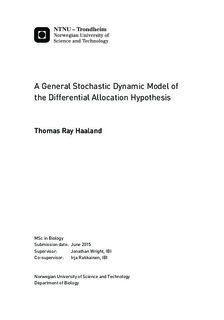A General Stochastic Dynamic Model of the Differential Allocation Hypothesis
Master thesis
Permanent lenke
http://hdl.handle.net/11250/2358855Utgivelsesdato
2015Metadata
Vis full innførselSamlinger
- Institutt for biologi [2571]
Sammendrag
Differential allocation (DA), adjusting reproductive investment according to the quality of the current mate, is an area of evolutionary behavioral ecology subject to much confusion, with vague terminology, apparently contradictory empirical results, and a shortage of theoretical work. I have created a state-based stochastic dynamic model of the differential allocation hypothesis in which females are mated with different quality males throughout their lifetime, and male quality affects either the costs or the benefits of the female's reproductive effort, or both, in various ways. I show that the elevation of the benefit function (offspring fitness function) has no effect on the optimal level of investment, and thus cannot produce DA, contrary to popular belief until now. On the other hand, the slope of the benefit function as well as the cost function shift the optimal level of investment by changing the marginal benefits or costs of extra investment. The elevation of the cost function can also cause weak DA, for females in low states when optimal investment cannot be achieved. Having identified and teased apart these distinct effects, I produce some more further model runs which aim at explaining certain patterns of DA seen in different species and mating systems. I discuss my results in light of existing empirical and theoretical literature. The model shows how the existing DA/RC (reproductive compensation) separation is of irrelevant, while other important theoretical distinctions are largely unknown. I can conclude that my model has shed new light on many confusing results in the field, and a natural next step in order to capture the wide variety of observed DA patterns is to expand the model to include several offspring per brood.
